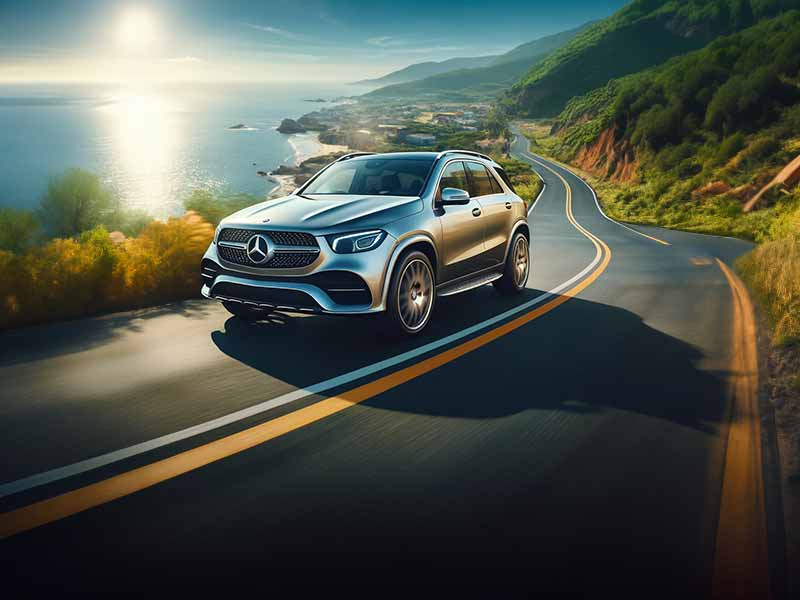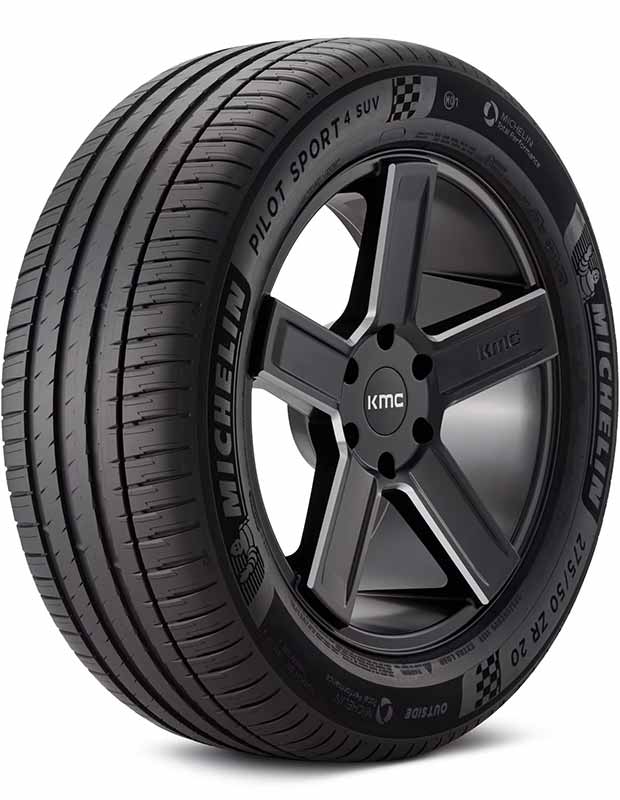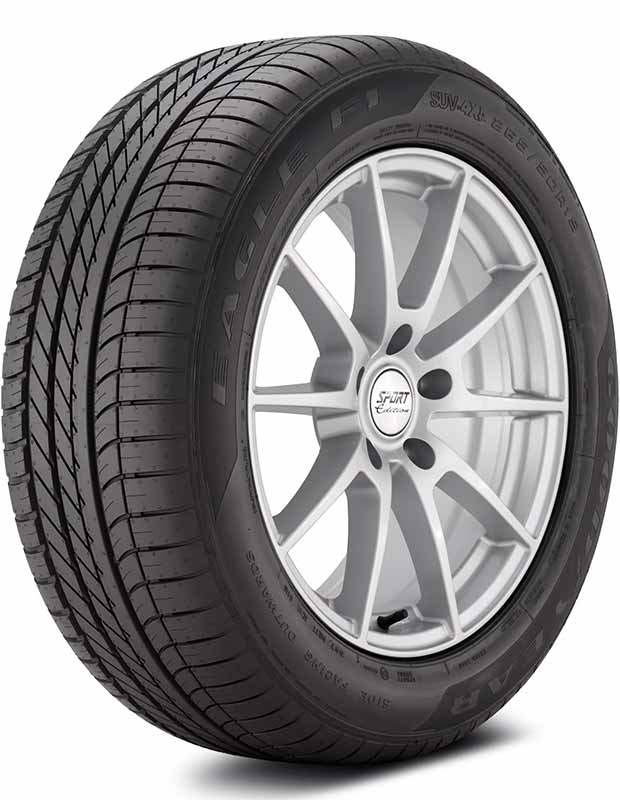Are you torn between the Michelin Pilot Sport 4 SUV and the Goodyear Eagle F1 Asymmetric SUV? It’s not just about the best bang for your buck; it’s about understanding the distinct capabilities and limitations of these two top contenders in the summer performance tire category.
The Michelin Pilot Sport 4 SUV excels in wet and dry conditions with superior traction and durability, while the Goodyear Eagle F1 Asymmetric SUV offers a budget-friendly option with reasonable performance.
In this article, we will provide a detailed comparison of the Michelin Pilot Sport 4 SUV and Goodyear Eagle F1 Asymmetric SUV, dissecting their performance in various conditions, comfort, and treadwear. We’ll also look at other competitive tires in the market to give you a broad view of your options.
Michelin Pilot Sport 4 SUV
Customer Rating
Overall Rating
8.7 of 10
Wet Weather
8.9 of 10
Winter Weather
N/A
Tread Wear
7.7 of 10
Dry Weather
9.3 of 10
Ride Comfort
8.9 of 10
UTQG
Uniform Tire Quality Grade
UTQG Treadwear Rating: 220
UTQG Traction Rating: A
UTQG Temperature Rating: A
Mileage Warranty
6 Years / 20,000 Miles
Find The Best Price
Key Performance Metrics
Hydroplaning: 8.8 of 10
Wet Grip: 8.9 of 10
Cornering: 9.3 of 10
Dry Grip: 9.4 of 10
Responsiveness: 9.3 of 10
Mild Snow Grip: N/A
Heavy Snow Grip: N/A
Ice Grip: N/A
Comfort Level: 9.1 of 10
Road Noise: 8.8 of 10
When you’re looking to grip the road like you mean business, the Michelin Pilot Sport 4 SUV tires come barreling into the conversation. Let’s peel back the layers on these high-performance rubbers and see what makes them stick.
Performance Ratings Explained
First off, these Michelins score an impressive 8.9 in wet conditions. What does that mean for you, the driver? It means when the skies open up and the road looks more like a slip ‘n slide, these tires hold on tight. With a hydroplaning resistance of 8.8, they’re nearly as good at slicing through puddles as they are at keeping stable on a soaked freeway. The wet traction score of 8.9 isn’t just a number—it’s peace of mind during a downpour.
Switch to dry roads, and the Pilot Sport 4 SUV really flexes its muscles. Scoring a solid 9.3, these tires offer corner stability that makes sharp turns feel like a smooth ride at an amusement park. With a dry traction of 9.4, they grip the road as if they’ve made a personal pact with the asphalt, and the 9.3 steering response means your car will be as nimble as a cat avoiding a puddle.
Comfort and Longevity
Ride quality scores a 9.1, which means less rumbling and more cruising. The noise level at 8.8 ensures your ride isn’t just smooth, it’s also whisper-quiet. Imagine gliding down the highway with only the sound of your playlist for company—these tires can almost make that a reality.
However, treadwear is where the Pilot Sport 4 SUV doesn’t shine as brightly, scoring a 7.7. While they offer excellent performance, they might not be the marathon runners of the tire world. This means you might find yourself shopping for tires sooner than you’d like if you clock a lot of miles.
Pros
- Stellar grip in wet and dry conditions.
- High corner stability enhances driving confidence.
- Exceptional ride quality makes for a comfortable drive.
Cons
- Lower treadwear rating indicates a shorter lifespan than some competitors.
Goodyear Eagle F1 Asymmetric SUV
Customer Rating
Overall Rating
6.9 of 10
Wet Weather
7.3 of 10
Winter Weather
N/A
Tread Wear
5.0 of 10
Dry Weather
8.1 of 10
Ride Comfort
7.3 of 10
UTQG
Uniform Tire Quality Grade
UTQG Treadwear Rating: 240
UTQG Traction Rating: AA
UTQG Temperature Rating: A
Mileage Warranty
None
Find The Best Price
Key Performance Metrics
Hydroplaning: 7.1 of 10
Wet Grip: 7.6 of 10
Cornering: 8.1 of 10
Dry Grip: 8.3 of 10
Responsiveness: 8.0 of 10
Mild Snow Grip: N/A
Heavy Snow Grip: N/A
Ice Grip: N/A
Comfort Level: 7.5 of 10
Road Noise: 7.1 of 10
Switching gears to the Goodyear Eagle F1 Asymmetric SUV, these tires bring a different set of strengths and quirks to the road. Let’s dive into what they offer and where they might fall short.
Performance Ratings Explained
In the realm of wet conditions, the Goodyear Eagle F1 Asymmetric SUV scores a 7.3 overall. Not quite top of the class, but still decent. They offer hydroplaning resistance at 7.1, which means they can handle water on the road, but they might not slice through puddles as confidently as some rivals. Their wet traction is a bit better at 7.6, suggesting that while they might not lead the pack, they won’t leave you slipping and sliding either.
Dry conditions see a bit of an uptick with these tires, as they score an 8.1 overall. The corner stability is also rated at 8.1, suggesting they handle turns adequately but without the standout agility of some peers. Dry traction comes in at 8.3, which is respectable and means they grip the road well under normal driving conditions. Steering response is noted at 8.0, solid yet slightly less responsive than what might be ideal for those spirited driving moments.
Comfort and Longevity
Comfort levels are scored at 7.3, with a ride quality of 7.5. This means they’re reasonably comfortable, though you might feel a bit more of the road’s texture compared to the plush ride of higher-scoring competitors. Noise levels are at 7.1, indicating a somewhat noisier ride, which could be a slight drawback for those who treasure silence on their drives.
Treadwear is where the Goodyear Eagle F1 Asymmetric SUV really needs to step up its game, scoring a mere 5.0. This is a significant consideration, as it suggests these tires may not endure as long as you’d hope. They offer performance, but at the expense of longevity.
Pros
- Adequate handling in wet and dry conditions.
- Respectable dry traction for everyday driving.
- Reasonable comfort for most road conditions.
Cons
- Lower scores in noise and comfort could impact the driving experience.
- Treadwear rating is low, indicating a need for potentially frequent replacements.

Comparative Analysis
When choosing the right tire for your SUV, the devil is in the details. Both the Michelin Pilot Sport 4 SUV and the Goodyear Eagle F1 Asymmetric SUV offer robust features for the discerning driver, but their strengths cater to slightly different driving preferences and priorities. Let’s break it down to help you decide which tire might be the best fit for your ride.
Performance in Wet Conditions
| Michelin Pilot Sport 4 SUV | Goodyear Eagle F1 Asymmetric SUV | |
|---|---|---|
| Hydroplaning Resistance | 8.8 | 7.1 |
| Wet Traction | 8.9 | 7.6 |
The Michelin Pilot Sport 4 SUV takes the lead in wet conditions with a score of 8.9, compared to the Goodyear Eagle F1 Asymmetric SUV’s 7.3. This higher score means the Michelin offers better traction and hydroplaning resistance, making it more suitable for areas prone to heavy rains or those who prioritize safety and control in wet environments.
Dry Traction and Handling
| Michelin Pilot Sport 4 SUV | Goodyear Eagle F1 Asymmetric SUV | |
|---|---|---|
| Corner Stability | 9.3 | 8.1 |
| Dry Traction | 9.4 | 8.3 |
| Steering Response | 9.3 | 8.0 |
Both tires perform admirably on dry roads, but the Michelin again edges out slightly with a score of 9.3 against the Goodyear’s 8.1. The Michelin offers sharper corner stability and steering response, ideal for those who enjoy a spirited drive. If you find joy in taking curves with confidence and need a tire that keeps up with aggressive steering, Michelin might be your go-to.
Comfort and Noise
| Michelin Pilot Sport 4 SUV | Goodyear Eagle F1 Asymmetric SUV | |
|---|---|---|
| Ride Quality | 9.1 | 7.5 |
| Noise | 8.8 | 7.1 |
On the comfort front, both tires offer a pleasant driving experience, but the Michelin’s higher scores in ride quality and noise control provide a slightly better environment for long drives. If you spend significant time in your vehicle and prefer a tranquil journey, the Michelin has a slight advantage.
Treadwear and Durability
| Michelin Pilot Sport 4 SUV | Goodyear Eagle F1 Asymmetric SUV | |
|---|---|---|
| Treadwear | 7.7 | 5.0 |
This category highlights a significant difference between the two tires. The Michelin Pilot Sport 4 SUV outperforms the Goodyear Eagle F1 Asymmetric SUV with a treadwear rating of 7.7 compared to Goodyear’s 5.0. This suggests that the Michelin tire will likely last longer, offering better value over time, especially for drivers who log many miles on their vehicles. However, if frequent tire changes align with your vehicle maintenance schedule or if budget constraints are a priority, the lower initial cost of the Goodyear may still appeal despite its quicker wear rate.
The Verdict
- Choose Michelin Pilot Sport 4 SUV if: You value superior performance in both wet and dry conditions and appreciate a tire that offers both comfort and durability. Ideal for drivers who face diverse weather conditions and want a tire that enhances the driving experience without frequent replacements.
- Opt for Goodyear Eagle F1 Asymmetric SUV if: You are looking for a cost-effective option that performs adequately across various conditions. Suitable for drivers who prioritize initial savings and are prepared for more frequent tire changes, perhaps aligning with shorter vehicle ownership periods or less aggressive driving styles.
In the tire tug-of-war, your choice will depend heavily on what aspects of performance and comfort matter most to you. Whether it’s the steadfast reliability and enhanced control of the Michelin or the budget-friendly and decent all-round performance of the Goodyear, both sets of tires have their place in the pantheon of SUV-ready rubber.
Other Competitors in the Market
While the Michelin Pilot Sport 4 SUV and Goodyear Eagle F1 Asymmetric SUV deliver commendable performance, the summer performance tire market offers a broader range of options that might better suit specific needs or budgets. Here’s a look at a few more contenders that bring their own unique strengths to the table.
General Grabber UHP
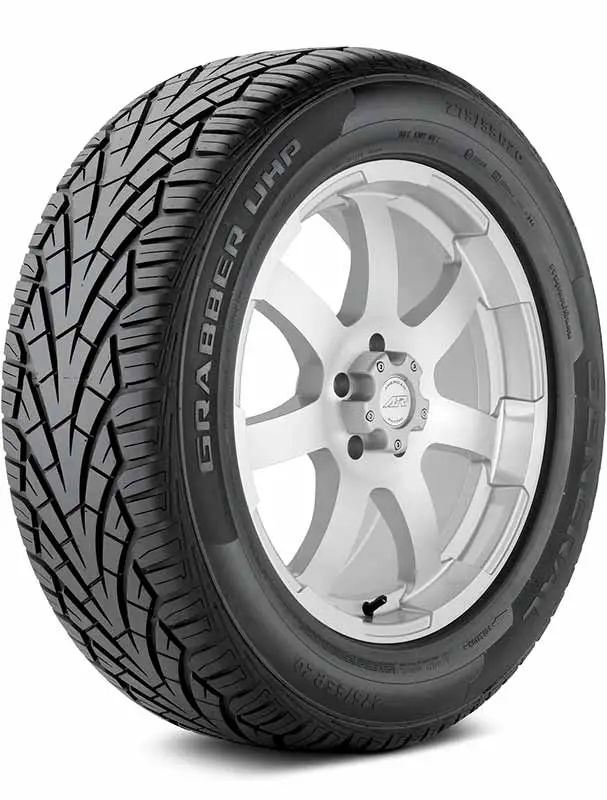
Performance Ratings:
- Wet: 8.7 (Hydroplaning Resistance: 8.7, Wet Traction: 8.8)
- Dry: 8.8 (Corner Stability: 8.7, Dry Traction: 9.1, Steering Response: 8.7)
- Comfort: 7.9 (Ride Quality: 8.2, Noise: 7.6)
- Treadwear: 7.9
Pros: The General Grabber UHP shows a solid all-around performance, particularly excelling in wet and dry traction.
Cons: While it boasts decent comfort and treadwear, its noise level might not be as hushed as some competitors.
Ideal Usage: This tire is a good choice for those who encounter varied weather conditions and appreciate a tire with balanced performance but can tolerate a bit more road noise.
Bridgestone Alenza 001
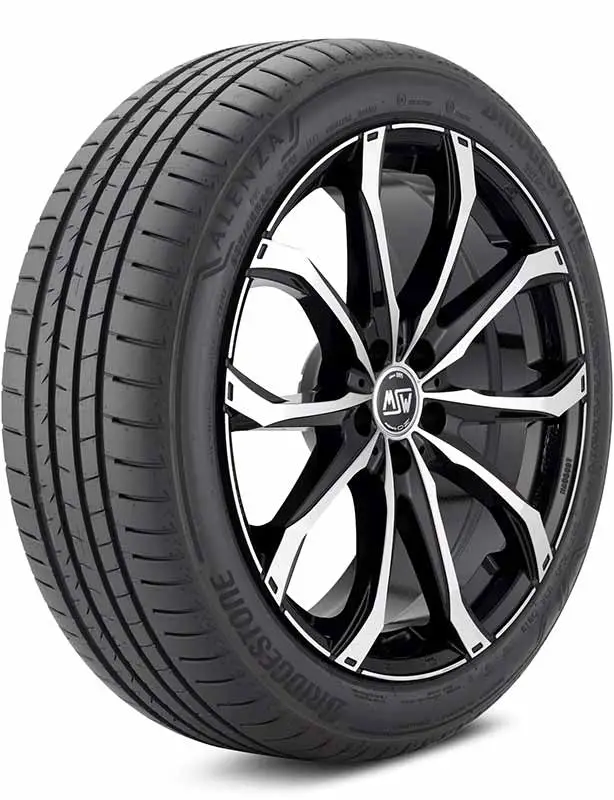
Performance Ratings:
- Wet: 8.3 (Hydroplaning Resistance: 8.3, Wet Traction: 8.3)
- Dry: 8.9 (Corner Stability: 8.9, Dry Traction: 9.0, Steering Response: 8.9)
- Comfort: 8.5 (Ride Quality: 8.5, Noise: 8.4)
- Treadwear: 7.5
Pros: The Bridgestone Alenza 001 shines in dry conditions with exceptional corner stability and dry traction, providing a smooth and responsive driving experience.
Cons: Its wet performance scores are good but not top-tier, and the treadwear score suggests a moderately quick wear over time.
Ideal Usage: Perfect for drivers in drier climates who value precision handling and a comfortable ride but are willing to compromise slightly on longevity.
Continental CrossContact UHP
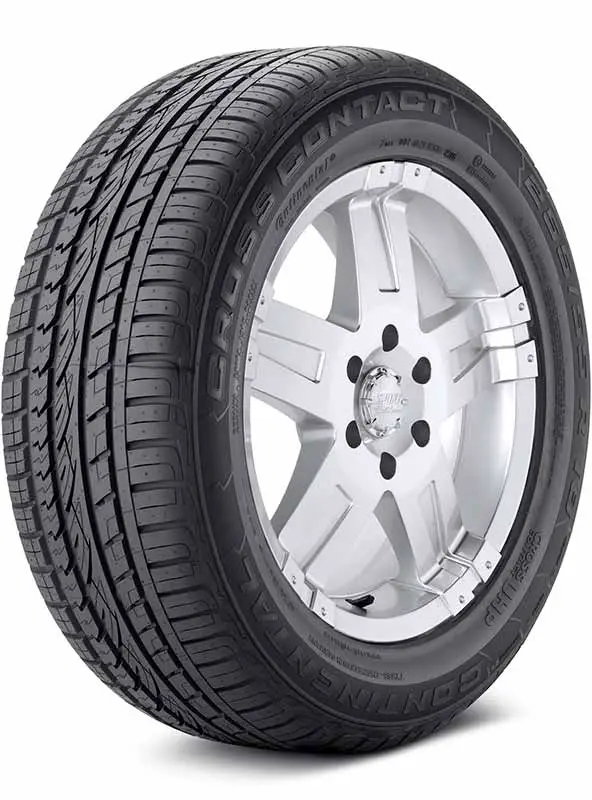
Performance Ratings:
- Wet: 8.2 (Hydroplaning Resistance: 8.1, Wet Traction: 8.3)
- Dry: 8.7 (Corner Stability: 8.5, Dry Traction: 8.9, Steering Response: 8.6)
- Comfort: 8.2 (Ride Quality: 8.2, Noise: 8.2)
- Treadwear: 6.6
Pros: Offers solid performance in both wet and dry conditions with a balanced profile in comfort and handling.
Cons: The major downside is its treadwear rating, which is the lowest among these alternatives, indicating a shorter lifespan.
Ideal Usage: Suitable for drivers who prioritize performance and comfort but may not be as concerned about replacing their tires more frequently.
Each tire brand and model brings something different to the road, and the best choice often depends on your specific driving conditions, vehicle requirements, and personal preferences. Whether it’s the balance of performance and price with the General Grabber UHP, the superior dry road prowess of the Bridgestone Alenza 001, or the solid, all-round performance of the Continental CrossContact UHP, there’s a tire to match every type of driver’s needs.
Resources
Below are some links you may find helpful when learning about tires:
- Michelin Product Page
- Goodyear Product Page
- Street/sport truck summer performance tire consumer ratings – Tire Rack
Final Thoughts
Choosing the right tire for your SUV involves considering how each tire performs under the conditions you expect to encounter most frequently. The Michelin Pilot Sport 4 SUV is your best bet if you’re after a tire that offers stellar performance in both wet and dry conditions and prioritizes longevity and comfort.
On the other hand, the Goodyear Eagle F1 Asymmetric SUV is more suitable for those on a budget, providing adequate performance across a variety of conditions but with a shorter lifespan. Remember, the right tire not only improves your vehicle’s efficiency and safety but also enhances your driving experience.
Good luck and happy motoring.
